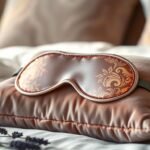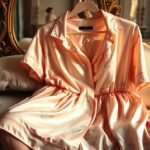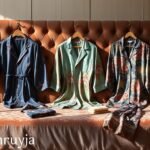Imagine wrapping yourself in the luxurious feel of nature’s finest fabric. Silk has been a wonder for thousands of years, known for its softness, shine, and strength1. It started in ancient China over 5,000 years ago1.
Silk comes from silkworms, which make their cocoons with a special protein called fibroin1. The way silk fibers reflect light gives it a beautiful shine. This has made silk a symbol of luxury and style1. It was loved in ancient Chinese courts and is still a top choice for fashion today.
Silk is not just a pretty fabric; it’s diverse and has a long history1. You can choose from smooth charmeuse, rustic tussar, or light georgette. There are many types of silk to discover.
Key Takeaways
- Silk is a luxurious natural fiber renowned for its sheen and softness.
- There are several distinct types of silk fabric, each with unique characteristics and uses.
- Silk has a rich history, originally cultivated in ancient China and traded along the famous Silk Road.
- Silk is used in a variety of applications, from clothing and accessories to home decor and furniture upholstery.
- Proper care and handling are essential to maintaining the beauty and longevity of silk fabrics.
Introduction to Silk Fabrics
Silk is a natural protein fiber2. It is known for its sheen, softness, and luxurious feel2. Silkworms make it when they build their cocoons2. The shimmering look of silk comes from its special structure that bends light2.
Understanding Silk: A Luxurious Natural Fiber
Silk has a long history, starting in ancient China around the 27th century BC2. China was the only one making silk for a long time, making it a big deal for them2. Silk has many types, each with its own look and use.
Exploring the Different Types of Silk Fabrics
Mulberry silk is the top quality, with smooth threads2. Tussah silk is less smooth but has a rich color and texture2. Charmeuse silk shines on one side and is matte on the other, perfect for dresses and blouses2.
Dupioni silk is a bit rough, with slubs and a shiny look2. Habotai silk from Japan is light, soft, and shiny, often used for linings2. Chiffon silk is very light, sheer, and a bit rough, great for evening wear2.
Crepe de Chine is soft, light, with a crinkled look and a bit of shine2. Raw silk is less smooth with more texture, in its natural state2. Satin silk is shiny on one side and matte on the other, sleek and often in luxury clothes2.
Organza silk is stiff, sheer, and crisp, often for weddings2.
Silk is breathable, keeps your temperature right, and dries quickly2. It’s used in many things, from clothes to furniture, each type adding its own touch.
| Silk Fabric Type | Characteristics | Common Uses |
|---|---|---|
| Mulberry Silk | Smooth texture, uniform size threads | Apparel, home decor |
| Tussah Silk | Rich golden hue, more textured | Apparel, upholstery |
| Charmeuse Silk | Shiny on one side, matte on the other | Dresses, blouses |
| Dupioni Silk | Slightly rough texture, lustrous sheen | Apparel, home decor |
| Habotai Silk | Lightweight, soft, glossy | Linings, scarves |
| Chiffon Silk | Extremely lightweight, sheer, slightly rough | Evening wear |
| Crepe de Chine | Soft, lightweight, slightly crinkled texture | Apparel, home decor |
| Raw Silk | Less smooth, more texture | Apparel, upholstery |
| Satin Silk | Glossy on one side, matte on the reverse | Luxury apparel, home decor |
| Organza Silk | Crisp, sheer, stiff texture | Bridalwear, home decor |
This guide shows the many types of silk fabrics and their special qualities2. Each silk type has its own benefits, making it great for fashion, decor, and furniture.
Mulberry Silk: The Finest Variety
Mulberry silk is one of the finest and most luxurious silks3. It comes from the silkworms of the Bombyx mori moth, fed on mulberry leaves3. These worms produce silk fibres up to 900 meters long, making the fabric smooth, soft, and shiny3.
Characteristics of Mulberry Silk
Mulberry silk is known for its strength, durability, and breathability3. It’s also moisture-wicking and hypoallergenic, perfect for clothes, bedding, and decor3. Mera Silk uses it in their clothes3.
Uses of Mulberry Silk
This silk is versatile, used in high-end clothes and home items like curtains and pillows3. It’s great for formal events and everyday wear too3.
Mulberry silk is the top quality silk4. It comes from silkworms that eat mulberry leaves, making it special4. It’s soft, smooth, and comfy, plus it’s hypoallergenic and breathable4.
China leads in silk production, with silk now made worldwide5. Mulberry silk is the best, graded from 3A to 6A, with 6A being the most luxurious5.
There are many types of silk, but mulberry stands out for its softness and strength5. It’s also hypoallergenic and durable5.
Charmeuse Silk: Smooth and Lustrous
Charmeuse silk is a top pick for luxury silk fabrics. It’s known for its smoothness and shine. The fabric has a satin-like finish on one side and a matte side6.
Its silky feel comes from the tight weaving of silk fibers. This makes the fabric look sleek and shiny. People love charmeuse silk for high-end clothes and home decor, like evening gowns and bedding6.
Charmeuse silk is very versatile. It’s great for formal and casual outfits, adding elegance to any look7.
Charmeuse silk is perfect for many things, like blouses, evening gowns, or pillowcases. It’s a mix of beauty, comfort, and strength. This makes it a top choice for luxury and style6.
Tussar Silk: A Rustic and Eco-Friendly Choice
Tussar silk is also known as ‘Tussah silk’ or ‘Kosa silk.’ It comes from the cocoons of wild silkworms, like the Antheraea mylitta species. These silkworms live in India, China, and Southeast Asia8.
They make tussar silk by taking silk fibers from the cocoons. The silkworms live their full life and turn into moths before the silk is taken8.
Origins and Production of Tussar Silk
Tussar silk comes from wild silkworms in the forests of India, China, and Southeast Asia8. These worms eat leaves from oak, sal, and arjun trees. This gives the silk its natural colors, like beige, golden, brown, gray, and green8.
This way of making silk is good for the planet. It doesn’t need a lot of farming or bad chemicals8.
Unique Characteristics of Tussar Silk
Tussar silk is known for its special texture and look. It feels a bit rough and has a unique texture that looks rustic and organic8. This comes from how it’s made, using wild silkworm cocoons8.
It’s also great at letting air in and keeping moisture away. This makes it perfect for hot and humid places8.
The silk comes in many natural colors, like beige, golden, brown, gray, and green8. These colors come from what the worms eat in the wild8. Its unique look and eco-friendly making make it a favorite among designers and buyers8.
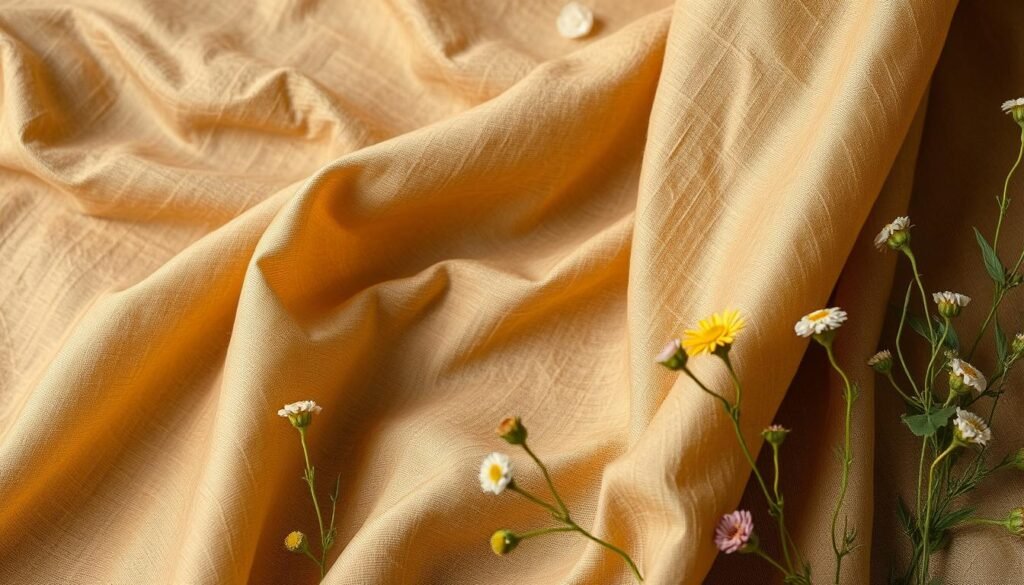
Habotai Silk: Lightweight and Versatile
Habotai silk is also known as China silk or pongee. It’s a lightweight and smooth silk fabric used in many things9. It comes from silk fibres in silkworm cocoons, woven into fabric for a smooth feel9.
This silk is great for draping and feels soft and flexible9. It comes in different weights for various uses9. Lighter types are for blouses and dresses, while heavier ones are for jackets and suits9.
It’s popular for its softness, breathability, and movement ease9.
Industry data shows habotai silk fabric weighs 1.1210. It’s known for its smooth, shiny, and soft feel10. Artists and designers love it for its color absorption10.
| Characteristic | Description |
|---|---|
| Weight | Lightweight to medium, suitable for various applications9 |
| Drape | Soft, fluid, and excellent draping properties9 |
| Texture | Smooth, lustrous, and soft10 |
| Dyeing | Excellent dyeing capabilities, absorbing color quickly and evenly10 |
| Applications | Clothing (blouses, dresses, lingerie), linings, home decor, and more9 |
Habotai silk is loved for its versatility and great qualities9. It’s used in many things, from delicate clothes to structured linings and home textiles9. Its light yet strong nature, plus its great draping and luxurious feel, make it popular in textiles9.
“Habotai silk is a true gem in the world of fabrics, offering a unique blend of softness, breathability, and ease of movement that makes it a perennial favorite among designers and fashion enthusiasts alike.”
Dupioni Silk: Distinctive Texture and Sheen
Dupioni silk is a type of silk fabric known for its unique texture and slubs11. It’s made from cocoons spun by two or more silkworms, making it thick and textured with a “slub” or bump11. These slubs make dupioni silk stand out with its unique look11.
The Unique Slubs of Dupioni Silk
The slubs in dupioni silk vary in size and density, adding to its unique character11. This texture makes the fabric visually appealing and interesting to touch11. The mix of slubs and natural sheen makes dupioni silk both structured and luxurious.
Applications of Dupioni Silk
Dupioni silk is great for making structured clothes like suits, jackets, and bridal gowns because it holds its shape well11. It’s also used in home decor, like upholstery and curtains, for its unique look and sheen11.
This silk is perfect for special events because of its sheen and luxurious feel11. It’s a favorite among designers and those who love silk for its versatility and unique look11.
In summary, dupioni silk is a silk fabric known for its unique texture and sheen11. Its slubs make it visually and tactilely interesting, making it great for many uses, from clothes to home decor11. It’s a silk fabric that will catch the eye and inspire anyone who sees it11.
Georgette Silk: Ethereal and Flowing
Georgette silk is a light, sheer, and flowing fabric. It’s often used in fashion to make elegant and feminine clothes12. It has a special crinkled texture that makes it stand out. This texture comes from the way the yarns are twisted together12.
The Crinkled Beauty of Georgette Silk
The crinkled look of georgette silk makes it move softly and shine slightly. It’s perfect for blouses, dresses, and scarves that need a light and dreamy feel12. This look comes from twisting the yarns in a special way12.
Georgette Fiori Soffioni ST000243 is 1.6 meters long. It was originally €37.30 but now it’s €31.7113. Georgette Se Fiori Filetto ST000215 is 6.8 meters long. It was also €37.30 but now it’s €31.7113. These fabrics show how versatile and affordable georgette silk can be.
“Georgette silk has a captivating crinkled texture that adds a sense of movement and softness to any garment.”
For making a flowing dress or a delicate scarf, georgette silk is a top choice12. It’s light and airy, great for summer or when you’re moving from one season to another. Its subtle shine and crinkled look add elegance and style.
A Fine Lustrous Silk Fabric: Exploring the Best Types of Silk
We’ve looked into silk fabric and its many types and features14. From the fancy mulberry silk to the earthy tussar silk, each type has its own special qualities14. We’ve checked out charmeuse silk, habotai silk, dupioni silk, and georgette silk too15. These silks show the beauty and flexibility of this natural, fancy fiber. They are used in fashion, home decor, and more.
Mulberry silk comes from silkworms of the Bombyx mori moth and is top quality16. It shines brightly and looks almost magical because it reflects light well16. This silk is also the longest and finest, making it very even and consistent16.
Charmeuse silk has a shiny look with a soft finish on one side. It’s great for clothes, lingerie, and fancy sheets1516. Tussar silk, from wild silkworms, has a rougher texture and comes in natural colors like beige, golden, brown, grey, and green14.
Dupioni silk is stiff and shiny, perfect for structured clothes like suits and wedding dresses. It has a special texture from cocoons of two or more silkworms1415. Habotai silk is light and has a simple weave, making it good for many clothes1516.
Georgette silk has a crinkly feel and looks flowing and sheer. Silk crêpe fabrics, like crêpe de Chine and crêpe georgette, have a bumpy look and a dull shine15.
Each silk type has its own special traits, making it good for different uses. From fancy mulberry silk to earthy tussar silk, silk offers many choices for fashion, home decor, and more. It shows the beauty, elegance, and versatility of this natural, fancy fiber.
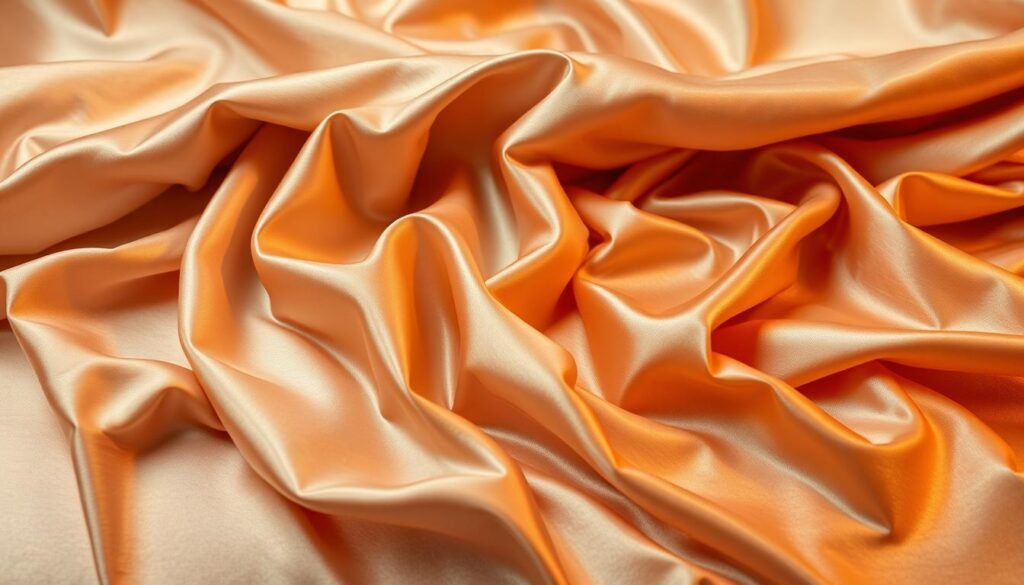
Silk Fabric Colors: A Vibrant Palette
Silk is a luxury fiber known for its wide color range. Silk in its raw form varies from white to beige or light gold17. The color depends on the silkworm type and its diet. Silk’s colors show where it comes from and the silkworms that make it17.
Natural Colors of Silk
Silk’s natural colors go from soft neutrals to gentle hues. It’s known for absorbing dyes well. This makes silk colors vibrant and deep17. You can use natural or synthetic dyes on it, offering many colors.
Dyed Silk: A Rainbow of Hues
Silk comes in almost every color, from pastels to jewel tones17. It shows off luxury and versatility. Two-tone or iridescent silks add a shimmering effect, making silk even more special.
| Silk Fabric Type | Characteristics | Best Uses |
|---|---|---|
| Dupioni Silk | Distinct furrowed texture, sheen from different thicknesses of yarn | Tailored pieces like wedding dresses, home decor, everyday wear |
| Shantung Silk | Soft touch, slight sheen | Wedding dresses, home decor, everyday wear |
| Silk Satin/Charmeuse | Lustrous, fluid quality, smooth touch, elegant sheen | Flowing wedding dresses, evening gowns, blouses, lingerie |
| Duchesse Satin | Heavier silk satin, pearly sheen | Structured garments like high-end wedding dresses, formal gowns, evening suits |
| Silk Crêpe | Matte sheen, pebbled texture, drapes well | Casual pieces and fancy items like scarves, tunics, summer frocks |
| 4 Ply Silk/Silk Marocain | Heavy, luxurious crêpe fabric with matte sheen | Formal wear and wedding dresses |
“Investing in high-quality silk, such as Grade 6A silk, results in longer-lasting products with timeless elegance and superior benefits compared to lower-grade silks or synthetic alternatives.”18
Silk’s versatility and colors make it popular for many uses. It goes from haute couture to everyday fashion and home decor. Silk, in its natural or dyed forms, always impresses with its beauty and luxury.
Caring for Silk Fabrics
Maintaining the look and feel of silk fabrics needs gentle care19. Wash silk clothes by hand in cold water with a soft detergent. Don’t rub or wring them hard, as it can harm the fibers19. Let the silk air dry flat, away from sunlight to stop color changes19. Keep silk in a cool, dry spot, like in garment bags, to avoid damage from light, heat, and moisture19.
Professional Cleaning for Delicate Silk Items
If a silk item is labeled ‘dry clean only’ or is very detailed, get a pro to clean it19. Experts know how to clean silk safely. They use special tools to keep silk looking and feeling luxurious19.
| Silk Fabric Type | Cleaning Recommendations |
|---|---|
| Mulberry Silk | Hand-wash in cold water with mild detergent, air dry flat |
| Tussar Silk | Dry clean only, avoid excessive washing |
| Charmeuse Silk | Dry clean or hand-wash in cold water, lay flat to dry |
| Silk Dupioni | Dry clean or hand-wash in cold water, reshape and air dry |
“Silk is a delicate and luxurious fabric that requires specialized care to maintain its beauty and longevity. Proper cleaning and storage techniques are essential to preserving the unique qualities of silk.”20
Silk in Home Decor and Furniture
Silk’s natural sheen and smooth texture make it great for furniture21. It’s often used on chairs, sofas, and more, adding a regal look21. Silk can make simple furniture look like a statement piece21. It needs special care to last in busy areas.
Silk Upholstery: Elegance and Luxury
Mulberry silk is popular for its smoothness22. Tussar silk is known for its unique texture22. Dupioni silk is great for formal items and decorations22. Silk is good for people with sensitive skin22. It also keeps things dry and comfy22.
Silk Curtains and Drapes: Softening Interior Spaces
Silk makes beautiful curtains and drapes21. These curtains spread light softly or block it for privacy21. They can also be used for fancy valances and swags21.
Silk keeps you warm in the cold and cool in the heat22. It hides fine lines and wrinkles, making it great for anti-aging items22. Silk adds luxury to any room with its curtains and upholstery22.
“Silk’s natural sheen, smooth texture, and fluid drape make it a highly sought-after material for upholstering furniture and crafting elegant curtains and drapes.”
Silk is a top choice for home decor and furniture212322. It adds beauty and comfort to any space212322.
Conclusion
In this guide, we looked at the world of silk fabrics. We saw everything from the finest24 mulberry silk to the rustic tussar silk. Each silk type has its own special qualities and uses. It’s a top choice for fashion, home decor, and more.
Silk is loved for its natural shine, smooth feel, and flowing style24. Its ability to take on many colors and dyes adds to its charm. Silk goes beyond clothes, making furniture and curtains look fancy25.
From budget-friendly26 mulberry silk pillowcases to fancy26 silk sheets, silk has many uses. It can make our lives better in fashion, home decor, or even personal care. Silk’s timeless beauty ensures it will always be popular.
FAQ
What is silk?
Silk is a luxurious natural fiber known for its sheen and softness. It has been valued for thousands of years, first in ancient China. Silk is made from the cocoons of silkworms and is mostly fibroin.
What are the different types of silk fabrics?
There are many types of silk fabrics, each with its own look and use. These include mulberry silk, charmeuse silk, tussar silk, habotai silk, dupioni silk, and georgette silk.
What are the applications of silk?
Silk is used in many things, like clothes, accessories, home decor, and furniture upholstery.
What is the shimmering appearance of silk due to?
Silk’s shine comes from its special structure that bends light.
What is the history of silk production?
Silk has a long history. China kept its secrets for centuries, leading to the famous Silk Road trade routes.
What are the key characteristics of mulberry silk?
Mulberry silk is known for its smooth, soft, and shiny texture. It’s strong and durable. The fine fibers make the fabric feel silky and look luxurious.
What are the uses of mulberry silk?
Mulberry silk is versatile and used in many things. It’s in high-end clothes, bedding, and home decor items like curtains and throw pillows.
What are the characteristics of charmeuse silk?
Charmeuse silk has a satin-like finish on one side and a matte finish on the other. It’s known for its smooth and shiny look.
What is the origin and production process of tussar silk?
Tussar silk comes from the cocoons of wild silkworms, like the Antheraea mylitta species. It’s produced by harvesting the silk from these cocoons after the worms complete their life cycle.
What are the unique characteristics of tussar silk?
Tussar silk is known for its unique texture and natural colors. It has a coarse texture and comes in colors like beige, golden, brown, grey, and green.
What are the characteristics of habotai silk?
Habotai silk is lightweight and smooth. It’s known for its excellent draping and versatility in weight and use.
What are the unique features of dupioni silk?
Dupioni silk is known for its texture and irregular slubs. These slubs give it a unique look that adds depth and interest.
How is dupioni silk used?
Dupioni silk is great for structured garments like suits and bridal gowns. It’s stiff and crisp, holds its shape well, and has a natural sheen.
What are the characteristics of georgette silk?
Georgette silk has a crinkled or crepe-like texture. This gives it a soft, flowing look and a subtle sheen.
What are the natural colors of silk?
Silk is usually creamy white, soft beige, or light gold. The color depends on the silkworm type and its diet.
What are the dyed color options for silk?
Silk can be dyed to create vibrant, deep colors. Both natural and synthetic dyes can be used, offering many shades from soft pastels to rich jewel tones.
How should silk garments be cleaned and stored?
Silk needs gentle care to keep its look and feel. Wash it in cold water with a mild detergent, avoiding rubbing or wringing. Store it in a cool, dry place, like garment bags, to protect it from light, heat, and humidity.
When should silk items be professionally cleaned?
For ‘dry clean only’ items or complex garments, get professional help. Experts have the right tools and knowledge to clean silk safely, keeping it looking luxurious.
How is silk used in home decor and furniture?
Silk adds a regal and sophisticated look to furniture upholstery. It’s also used for curtains and drapes, softening and enhancing room ambiance.


